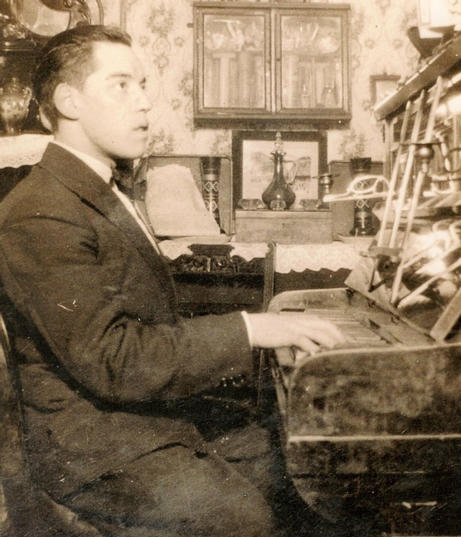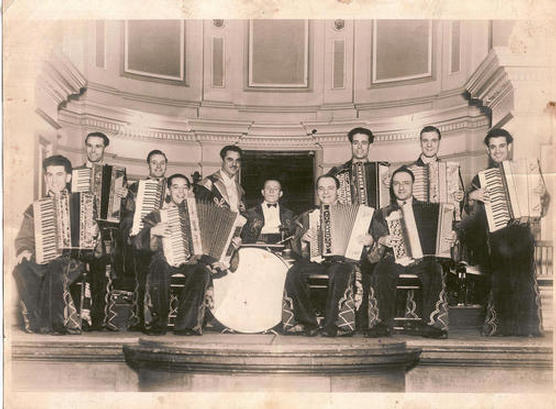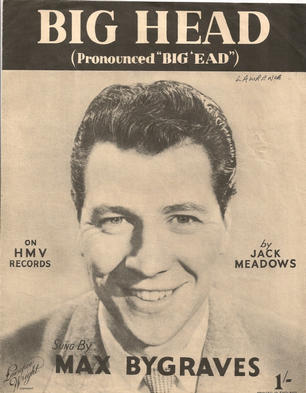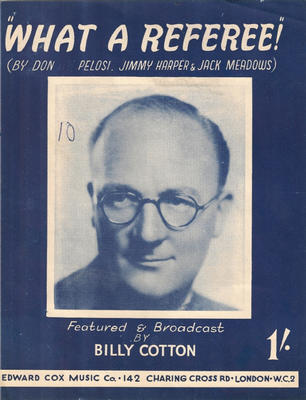Alfred Meadows
Alfred John Meadows was born in about 1833 in Essex. In the 1851 census he gave his place of birth as Ongar, but in all the other census records from 1861-1891, his birthplace is recorded as Mountnessing. Alfred was the great-great-great-grandfather of your humble scribe, the webmaster. Ironically, Alfred is the son of James Meadows who most appears to epitomise "the artist's life" with all that that entails, but whose works are the hardest to find. His career and personal life suggest that he was the least successful of the brothers.
Alfred's adventures begin with the 1851 census, when he is recorded separately from his family who were living in Clapham. Aged 18, Alfred is recorded in Lambeth as an artist visiting another family originally from Stepney, where the Meadows family principally lived from the late 1830s onwards. The fact that he gave his profession as an artist at such a young age, and that he was to be found in Lambeth, may suggest that he was assisting his father as a scene painter at the Surrey Theatre in Lambeth.
Surprisingly, the next 'sighting' of Alfred was in Birmingham in 1854, as the father of his first-born child, when Alfred the artist and his future wife, Ellen Leonard, were living in King Edward's Road. By 1856, the young family had moved to Christian Street in Liverpool when a second child was born. But it was not until the following year, when Ellen came of age and the family was living in Clare St, that the couple were finally married at Liverpool Parish Church. Throughout this period, Alfred gave his profession as "artist". As if being a pair of under-age runaways with two children born out of wedlock was not enough, Ellen was apparently a chorus girl from 'The Lyceum' in London, a "notorious" profession.
By 1859, Alfred, Ellen and their daughters had returned to London's East End, to Mile End and the Meadows family fold. With the exception of a period in Deptford in the mid-1860s, Alfred and his family moved home frequently in the East End, in Mile End, Bethnal Green, Spitalfields, and Whitechapel, until the deaths of Alfred and Ellen in 1894. In total Alfred and Ellen had 9 children, but at least 4 died in infancy, with at least three dying in the same fatal year, 1861
Alfred's return to London, and the increase of his family, coincided with erratic changes in his recorded professional occupations. From 1860 to 1871, he gave his occupation as a "house painter", and even "master house painter" in 1865! But on the birth certificate of his 6th child in 1863, he gave his profession as "actor". In 1881, Alfred was recorded as "house painter, actor and artist"; in 1887, as "artist"; in 1891, as "painter and paper hanger" (paper hangers worked for professional artists); and on his death certificate in 1894, he was recorded as a "scenic artist". Therein lies the clue. This appears to confirm information from a family source, that Alfred was an "artist, actor and scene painter at the Lyceum Theatre" in London.
Examples of Alfred's works are hard to find, and so far only three examples have been identified from sale recors: "A Derbyshire landscape", dated 1862, and two rural scenes in Kent, auctioned in 2008. To visualise the two scenes in Kent, follow the link below to the fascinating 'Meadows Story' website, recently created by Roger and Jeff Meadows.
After at least 40 years together, Alfred and Ellen died within months of each other, both in the presence of the family they had braved convention and hardship to raise. Alfred died in April 1894 in the presence of his son, in Mile End Infirmary. Ellen died two months later in Mile End in the presence of one of her daughters.
The children and grandchildren of Alfred & Ellen Meadows
Catherine Eleanor Meadows, born in Birmingham 1854, died in Whitechapel 1861.
Jessie Ann Meadows, born 1856 in Liverpool.
Frances Rosetta Meadows, born 1857 in Liverpool, died in Whitechapel 1861.
Alfred James Meadows, 1860-1861, Whitechapel.
Minnie Gertrude Meadows, 1868-1871, Whitechapel.
Christine Amelia Meadows, born 1859 in Whitechapel. In 1887, Christine married Frederick Schloen (born c.1855 in Bethnal Green), a carpeneter and widower, at St Andrew's Church, Bethnal Green. They had at least 6 children, all girls born in Bethnal Green: Daisy, c.1889; Christine, b.1890; Elizabeth, b.1892; Jessie, born c.1894; Ethel, b.1896; and Ruth, b.1899. In 1901, the family were living in Spring St, Bow.
Lillian Maud Meadows, born 1863 in Stepney. In 1887, Lillian married Richard Small (born c.1863 in Shadwell), at St Andrew's Church, Bethnal Green. They had at least 4 children all born in Mile End: Christine, born c.1888; Edward, born c.1894; Lillian, born c.1897; and Walter, born c.1901. Lillian's mother, Ellen Meadows, died in the presence of Lillian at their family home in Clark St, Mile End, in 1894. In 1901, Richard was a stevedore.
Kate Edith Meadows, born 1869 in Bethnal Green. Like her sisters, Kate also married in 1887 at St Andrew's, Bethnal Green. Her husband was Richard Oddy, (born c.1865 in Weymouth), who at the time was a bill poster, but later became an "artist's messenger and labourer". They had at least 5 children: Lilly (born c.1888 in Bethnal Green); Nelly (born c.1890 in Bethnal Green); Richard, born c.1892; May, born c.1894; and William, born c.1897.
Sidney Walter Meadows, born 1865 in Deptford. The year 1887 was quite a year for weddings in the the Meadows family, as all four of Alfred and Ellen's children married in the same year! Sidney was married at St Mark's Church, Old Street, to Jane Wregge (born 1867 in Holborn). Sidney and Jane were neighbours at time in Charles Square, Hoxton. Sidney had been a mason's labourer, but from 1891-1916, he gave his profession as "walking stick fitter", although he later became a builder. Sidney and Jane lived with Jane's family in New Street until 1895, a side street opposite Liverpool Street Station which led on to Petticoat Lane. From 1895, the family moved to various addresses in the parish of St Luke's, Finsbury, between Old Street, City Road, and Moorfields Eye Hospital.
Sidney and Jane had 11 children, of whom three died, and two may have been named after their Meadows relatives:
Christine Emily May Meadows born 1888, married Frederick Allwright at St Mark's Church, Old Street in 1913.
Alfred Sidney John Meadows, born 1889, joined the Duke of Cornwall's Light Infantry and died in action in July 1916 at the Battle of the Somme. He is commemorated at Thiepval Cemetery on the Somme. The link below allows you to view the fine war memorial in his former school, and the entry concerning his death.
William George Meadows, born 1891 and died in 1892 in Islington
Lillian Edith Meadows born c.1894 in Islington. In 1919, Lillian married Alfred Barton, a petty officer in the Royal Navy, at St Luke's Church, Finsbury, across the road from the family home in Radnor Street.
Marguerite Meadows, born and died 1895 in Islington
Arthur Gordon Meadows, born 1896 and died 1898 in Islington
Daisy Cornelia Meadows, 1899-1975. In 1922, Daisy married Charles William Cody, (1899-1965),at St Mark's Church, Old Street. Daisy and Charles had six children. Before World War Two, the Cody family lived in Peerless Street, adjoining Radnor Street and Baldwin Street where other Meadows family members lived. For a while, they also lived in Clapton and Dalston. Following the outbreak of World War Two, the family was evacuated to Norfolk, and then Hertfordshire during the Blitz. Finally in 1941, the family moved to Harringay.
Ivy Rose Jane Meadows, born 1906 in Islington
Albert Edward Meadows, born 1904 in Islington
Horace George Meadows, 1908-1993.
Sidney Richard "Jack" Meadows, 1902-1956 - Described in his obituary as "a dapper Londoner", Jack Meadows was born at the family home in New Street, opposite Liverpool Street station. Like his parents before him, he also lived in Charles Square, Hoxton. In 1923 he married Ada Wells at St Paul's Church, Clerkenwell. The Wells family were furriers, and lived in Baldwin St, the continuation of Radnor St. Jack and Ada Meadows had seven children.

Although Jack gave his profession as "housepainter", and also claimed to have played football for Clapton Orient, (now Leyton Orient FC), he toured frequently between the wars with Louis Mexano's Accordion Band, appearing under the stage name of "Jack Martini ".
The Mexanos were founded by two brothers from the London Italian community down the road in Holborn. From 1933, the band began to tour extensively and notably in the Stoll Moss chain of theatres. In 1934 they appeared at the Blackpool Opera House in the hit summer revue, « King Folly », directed by Jack Taylor and alongside the comic Billy Bennett (an inspiration later of George Formby whom Taylor also launched in Blackpool in 1937, Tommy Cooper, Ken Dodd and Spike Milligan), Randolph Sutton (a music-hall star for over thirty years best remembered for the hit, « On Mother Kelly’s Doorstep »), and the Ganjou Brothers. Ironically, the final scene of "King Folly' was a 'transformation' scene of the kind pionneered by Jack Meadows' great-grandfather, the scenic artist James Meadows. In 1935, Taylor produced a new show at The Alhambra, Leicester Square in London (now the Odeon Cinema), which included The Mexanos, and also Ralph Sutton, and the comedian and actor Jimmy James. Many of these stars who appeared alongside The Mexanos later appeared not only in pantomime but also in the annual Royal Variety perfomances in London.
At the end of 1935, The Mexanos appeared at the The Cheslea Arts New Year Ball at the Royal Albert Hall. Later tours in the 1930s took the band back to the north of England, where they began live radio broadcasts. Other members of the Mexanos included the future jazz violinst Johnny Van Derrick ; Jack Emblow who founded a popular Jazz Sextet ; and Jimmy Golding who went on to found his own accordion band. When war was declared in 1939, the Mexanos were touring, and the band's founders soon signed up to ENSA and toured with band members entertaining the troops. Jack Meadows’ family, meanwhile, was evacuated to the relative safety of Kingsbury in north-west London where they settled.

Jack Meadows (seated 2nd left above, and standing 2nd left below), with his band in the 1930s. (Photos reproduced by kind permission of Pam Sims).

After the war, Jack made a career as a singer-songwriter, and together with Don Pelosi and Jimmy Harper composed, "Oh! what a referee!" in 1950 for the BBC bandleader Billy Cotton and his popular Sunday lunchtime radio show 'Wakey! Wakey!', before teaming up with Max Bygraves (a favourite guest on the Billy Cotton show), who became a regular visitor to the Meadows family home. In 1951, Jack Meadows composed the music and lyrics for "How could people tell I was a cockney?" for Bygraves to perform when he supported Judy Garland on her tour of the USA. Jack was also the author of several of Bygraves' early hits: "(Why does everybody call me) Bighead" (1953), "She was a good girl" (1954) and "Conkers" (1954). Later in his career, Bygraves also included "Oh what a referee!" in one his compilation albums.


|